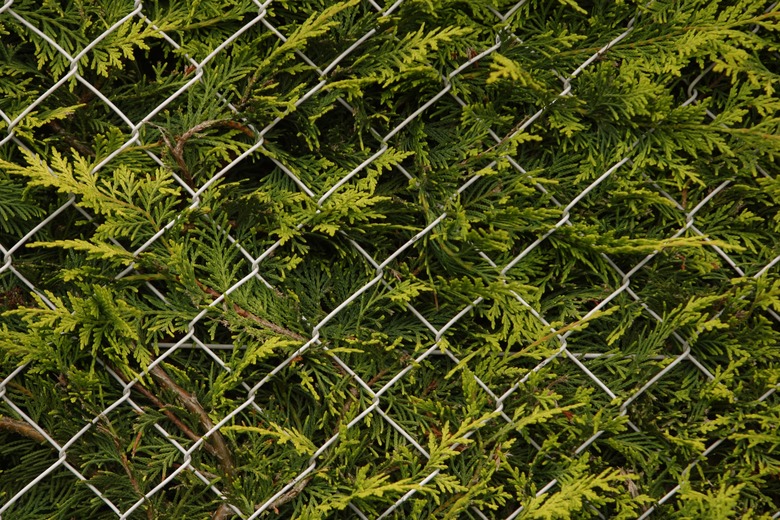The Best Time To Trim Arborvitaes
The soft, flattened sprays of scaly needles makes arborvitae (Thuja spp.) among the most attractive conifer trees and shrubs for gardens. Of the five species of arborvitae, and dozens of cultivars, most are used as tall hedgerows or as small accent shrubs for building foundation beds or mixed shrub borders. The best time to conduct any pruning maintenance on arborvitae is in early spring, before new growth begins.
Pruning Season
Dead, broken or diseased twigs or branches on arborvitae plants may be removed any time of year. This includes cutting away massive webworm nests or excessive evergreen bagworm cocoons. If you wish to shape or shear an arborvitae, early to mid-spring is the proper season to complete the task. Trimming the tips of the foliage sprays and branches this time of year results in the fastest healing of cut wounds, with ample time before summer for new growth to appear.
- The soft, flattened sprays of scaly needles makes arborvitae (Thuja spp.)
- Trimming the tips of the foliage sprays and branches this time of year results in the fastest healing of cut wounds, with ample time before summer for new growth to appear.
Summer Pruning Insight
Trimming arborvitae in the intense sun rays and heat of summer isn't a good practice. The fresh pruning wounds on both twigs and needle sprays quickly dry and brown, resulting in a tree or shrub with a singed texture or color across its leafy canopy. However, a secondary trimming of arborvitae hedges is warranted in late summer, such as mid-August to early September. To maintain the straight or formal curves of the arborvitae specimen or hedgerow, a light trimming in late summer removes any extra growth that occurred since spring. This keeps the plants at roughly the same size year to year, rather than growing a lot larger than desired.
Technique
Arborvitae, unlike many other conifers, has the capabilities to rejuvenate new foliage from lower parts of a branch that lacks foliage. This new foliage occurs only if that part of the arborvitae receives ample sunlight and the soil is fertile and evenly moist afterward. Focus trimming branches of arborvitae by cutting more vertically angled twigs than horizontal ones. Once a horizontal branch or needle area is cut, it tends not to produce more horizontal regrowth. New growth sprouts most readily from upward-angled branches, twigs and foliage sprays.
- Trimming arborvitae in the intense sun rays and heat of summer isn't a good practice.
- To maintain the straight or formal curves of the arborvitae specimen or hedgerow, a light trimming in late summer removes any extra growth that occurred since spring.
Preventing Uneven Plants
The best foliage and mature silhouette occurs on arborvitae grown in full to partial sun, and not shaded by close-by plants. Ample sunlight ensures the arborvitae remains densely leaved and no barren or "bald spots" develop. When trimming these evergreens — ensuring they're trimmed in the proper season of early to mid-spring — angle the pruning so the bottom of the plant is wider than at the top. This allows light to reach the lowermost branches and needles so they remain green and dense. From the side profile, a properly pruned arborvitae should look more like an "A" than a "V." Naturally rounded or globe-shaped specimens are also best trimmed slightly wider at their bases so light reaches the lowest needles.
References
- University of New Hampshire Cooperative Extension; Pruning Evergreens in the Landscape; David Seavey, et al.; 2001
- North Dakota State University; Questions on Arborvitae; Ron Smith
- "A-Z Encyclopedia of Garden Plants"; Christopher Brickell and H. Marc Cathey, eds.; 2004
